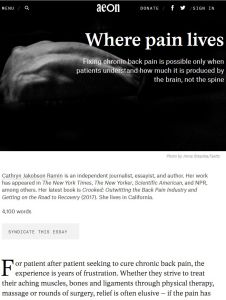
Where Pain Lives
Fixing chronic back pain is possible only when patients understand how much it is produced by the brain, not the spine.
Recommendation
You and a friend both get MRIs of your spines, and both reveal bone spurs, ruptured discs and spinal degeneration. You are incapacitated by back pain, but your friend springs up from bed every morning with the vigor of a 20 year old. It turns out that there’s little correlation between spinal imaging results and chronic back pain. And unfortunately for you, traditional treatment options offer limited relief. getAbstract recommends Cathryn Jakobson Ramin’s smart, engaging essay to readers who suspect that “the reign of pain is mainly in the brain,” or to those who deny it.
Summary
About the Author
Cathryn Jakobson Ramin’s work has appeared in The New York Times, Scientific American and NPR. Her book Crooked: Outwitting the Back Pain Industry and Getting on the Road to Recovery came out in 2017.








Comment on this summary